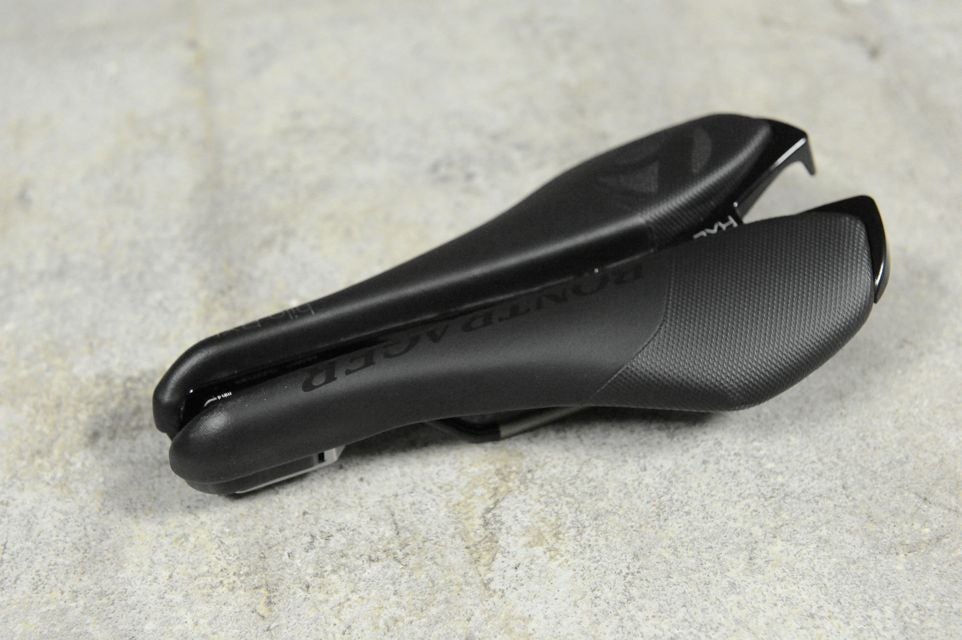Interbike 2012: Custom Saddle Fit

Bontrager's Hilo RXL Speed Dial saddle. Photo: Aaron Hersh
Bontrager’s Hilo RXL Speed Dial offers unprecedented fit adjustability in a true tri saddle.
Triathlon saddles with a split all the way to the nose have been rocketing up the Kona count since the ISM Adamo debuted. This saddle style has won many devotees because they’re able to keep blood flowing for many riders, even in an aggressive triathlon position, but this attribute comes with a compromise. They’re broad, so some split saddles chafe some riders. But they need to be broad to accomplish their primary purpose and the ideal width for each individual rider seems to fall in a very narrow range. Bontrager has a solution.
Their first anatomical triathlon saddle, the Hilo RXL Speed Dial ($250), adds a unique layer of fit adjustment. The gap between the two support tongs at the front of the saddle can be widened and narrowed to suit rider preference. Instead of guessing the space required to keep blood flowing (wider is generally better) while minimizing inner thigh chaffing (narrower is generally better), the Hilo RXL Speed Dial has an adjustable spreader between the two tongs that can be moved substantially to let the rider find their own ideal saddle nose width.
Through early ride testing, we’ve found the adjustable-width nose to be very effective. Bring a 5mm Allen wrench on a ride (found on pretty much every bike-specific multi-tool) and you can micro-adjust the saddle gap minute by minute to find your ideal fit dimension. An individual’s perfect saddle spacing might even change from ride to ride. Narrowing the gap a fraction when wearing tri shorts with a thing pad instead of cycling bibs with a robust chamois helped the tester find the sweet spot on the saddle.
After trying just about every tri saddle out there, I typically ride the ISM Adamo Race or Podium because they reduce numbness for me more than any other saddle. I tolerate the mild leg chaffing they create for me as a trade-off. The construction of the saddle tongs themselves impacts blood flow (more on that later), but the Hilo RXL Speed Dial’s adjustability completely eliminated thigh chafing without causing the saddle to act like a tourniquet. This is a genuine breakthrough. Just as Specialized and others offer saddles with variable width bodies to contact sit bones when riding a road position, Bontrager’s saddle demonstrates that tri saddle comfort relies heavily on tong width and saddle makers should be providing width options.
The width range that maximized blood flow and reduced chaffing was surprisingly narrow. One or two millimeters made all the difference. I ended up settling on a fairly wide position, so the outer edges of the tongs were only a hair closer than the Adamo Race I rely on.
Saddle fit theory aside, the Hilo RXL Speed Dial is quite comfortable and extremely versatile. In addition to allowing excellent blood flow in a triathlon position without chafing, the saddle’s narrow rear section lets the rider slide backward into a comfortable upright position without additional problems. For dual road-tri position comfort, it’s hard to beat. The cushioning on the tongs is fairly soft. It allowed me to sink into the saddle a little more than is ideal. Slightly sturdier padding might help the Hilo RXL SD provide maximum benefit from its anatomical design.
The width adjuster is a solid piece of metal, so it adds some bulk to the saddle. Bontrager is making a fixed-width version (called the Hilo RXL) that weighs about 80 grams less and costs $70 less, if you happen to fit the stock version. The rear of the saddle is a handy transition rack hook and the saddle can still mount to standard saddle rail clamps when spread wide.
RELATED – Triathlete Buyer’s Guide: Saddles